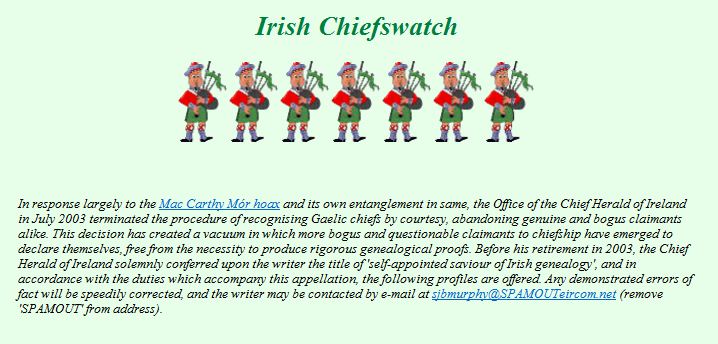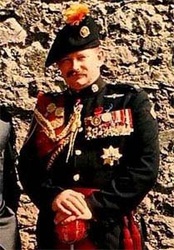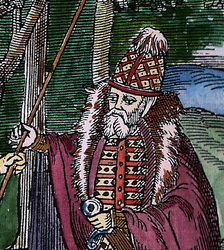- CLAN O'BYRNE HOME PAGE
- New Page
- NEW!! UNCOVER YOUR PAST ! !
- CLAN O'BYRNE EVENTS ARCHIVE
- Who do YOU think you are ? The Clan O'Byrne DNA Project
- FORUMs
- BYRNE HERALDRY
- Clan O'Byrne Gathering Rally Poll
- The Gathering Rally Quick Guide
- News , Updates and Archives
- Clan O'Byrne Background
- The Clans of Ireland
- Histories of the O'Byrnes
-
Sept families of the Leinster Byrnes
- Leinster Clans Alliance
-
Clan Rallies of the O'Byrnes
- St. Geri 2008
- Well known and not so well known Byrnes
- Ancestors sought and hoped for.
- Blogs for Byrnes
- Clan O'Byrne Video Vault
- Publications, Links and Sources
- Irish Order of Knighthood
- Google Wicklow
- Drives thro County Wicklow
- Membership registration form
- Clan Ó Byrne Members only
The Niadh Nask: An Alleged Irish Order of Knighthood
In what has been undoubtedly the greatest Irish genealogical and heraldic fraud of modern times, Terence MacCarthy of Belfast claimed until his enforced 'abdication' in October 1999 to be a Gaelic Chief, 'The MacCarthy Mór', and also 'Prince of Desmond', head of the 'Royal Eóghanacht Dynasty of Munster'.
Crucial to MacCarthy's operations was an organisation known as the 'Niadh Nask', an alleged ancient Gaelic order of knighthood in the gift of his 'dynasty' whose members supposedly wore a 'golden chain'. Is there in fact any evidence that such an order ever existed?
MacCarthy's hoax was publicly exposed by the present writer and a Sunday Times article in June 1999 (for a summary account of the affair see http://homepage.eircom.net/~seanjmurphy/irhismys/maccarthy.htm).
A month later the Chief Herald of Ireland withdrew recognition of MacCarthy's chiefly status, a rather belated action given that his Office's management had known for years that he was bogus. Up to this point, and largely because its Chief enjoyed the endorsement of the Chief Herald's Office, the Niadh Nask had successfully attracted a membership of over 400, some of whom were admitted gratis on account of their prestige, but most of whom paid $850 for the privilege. Thus the Niadh Nask operation may have contributed about $250,000 to the estimated $1,000,000 which the MacCarthy Mór Hoax gathered in (one source puts the money total as high as $4,000,000, which may be an exaggeration). The membership of the Niadh Nask included former Irish Prime Ministers Charles Haughey and Albert Reynolds, a number of Irish Chiefs both real and fake, the heraldic expert Gerard Crotty, the former Norroy and Ulster King of Arms John P B Brooke-Little, a brace of American military men including General William Westmoreland, and some other notable figures such as the author Peter Berresford Ellis and the academic Dr Katherine Simms (The Niadh Nask
International Roll 1998, Clonmel 1998).
Terence MacCarthy is himself a trained scholar and graduate of Queen's University Belfast, being dubbed by a fellow 'Chief', O Long of Garranelongy, as 'Tadhg na Leabhair' or 'Terence of the Books'. The voluminous series of MacCarthyite publications includes a collection of essays on the Niadh Nask edited by MacCarthy's associate Andrew Davison, the equally bogus 'Count of Clandermond' and indeed 'Secretary General' of the order (Links in a Golden Chain, Royal Eóghanacht Society, Clonmel 1998). Among the book's contributors is the former 'Ollamh' or Historian to MacCarthy, Peter Berresford Ellis, who lamented the 'ignorance of the realities of Gaelic Ireland'
displayed by Irish historians, who were allegedly unaware even of the existence
of the Niadh Nask (Links, page i). MacCarthy's contribution is a piece on the history of the Niadh Nask, which to the unwary may appear to be structured and referenced in a scholarly manner (Links, pages1-27).
MacCarthy quotes from a range of sources to support his contention that the
Niadh Nask had existed for centuries, having been founded by King Muinheamhoin
and bestowed by kings of the Eóghanacht Dynasty, later being kept in existence
by their noble MacCarthy descendants. These are all very large claims which of
course need to be examined critically.
James Algrant first publicly raised doubts about the Niadh Nask in 1997, in an article which can still be read at http://caltrap.bbsnet.com/page1.html, and which perceptively forecast that the order's 'nobiliary claims will certainly be the subject of debate and amusement for many years'. MacCarthy's furious response apparently included a threat of criminal libel proceedings, a technique used with other critics as well. In addition to querying MacCarthy's title and pedigree, contributors to the Internet discussion group rec.heraldry began asking questions about the Niadh Nask around the same time, which MacCarthy's then strong band of supporters could not satisfactorily answer. In the wake of MacCarthy's exposure in 1999 the present writer received a copy of a referenced report by another author, who indicated that he wished to remain anonymous, which report claimed that MacCarthy's account of the Niadh Nask was laden with historical distortions and outright fabrications. The writer has personally
checked the references in this report and found them to be substantially correct. Thus, for example, Geoffrey Keating is quoted by MacCarthy as follows:
No king could settle down in Tara till he should first wear
the Nasc Niadh around his neck. This was the same as to say that he should have
received the degree of knight of chivalry. For as the knight of chivalry is
called Miles Torquatus, so also Nia Naisc is applied in Ireland to these
champions. (Links, page 8.)
Now Keating was a somewhat credulous author who tended to repeat legend as
fact, but in this case he is being made to say more than he had written. What
MacCarthy omitted to show was that Keating was quoting and glossing a mythical
'learned druid' who declared that it was one of the geasa or taboos of Tara,
'that no king should settle down in Tara with a view to
assuming the sovereignty of Ireland till he should first wear the nasc niadh
round his neck.'
This was the same as to say that he should have received the degree of Knight of Chivalry. For as the knight of chivalry is called Miles Torquatus, so also Nia Naisc is applied in Irish to the champion who wore a nasc or chain round his neck. (Keating, History of Ireland, 2, Irish Texts Society, London 1908, page 405.)
In a like vein, MacCarthy cites another source:
. . . the Annals of Clonmacnoise which record that:
'Mownemon was the first king that ever devised golden chains fit to be
worn about men's necks . . . He was of the sept of Munster'. Here then, for the
first time, we have a clear allusion to The Niadh Nask as a Momonian order.
(Links, page 5.)
Here is the full quotation, in the archaic early seventeenth-century English of the translator Conell Mageoghagan:
Mownemon was the first king that ever divised goldin chains
fit to be worn about men's neckes and rings to be put on theire fingers, which
was then in great use, he raigned five yeares and then died. He was of the sept
of Munster.
(Denis Murphy Editor, The Annals of Clonmacnoise, Royal Society of Antiquaries, Dublin 1896, page 34.)
What we have here is a simple statement concerning fashionable adornments, with no indication whatsoever of the existence of the Niadh Nask as a
'Momonian' or any other kind of order.
More seriously, MacCarthy quotes a reference from the twelfth-century text
Caithréim Ceallacháin Caisil thus:
For the heroes had neither blue helmets, nor shining coats of
mail, but only elegant tunics with smooth fringes, and shields, and beautiful,
finely wrought collars of gold to protect bodies, and necks and gentle heads.
(Links, page 5.)
In fact, the exact quotation is as follows:
For the heroes had neither blue helmets nor shining coats of mail, but only elegant tunics with smooth fringes, and shields, and beautiful, finely wrought collars to protect bodies, and necks, and gentle heads. (Edition compiled by Alexander Bugge, Christiania 1905, page 64.)
The substitution of 'collars of gold' for plain 'collars' is no mere transcriber's slip, but a textual fabrication designed to give spurious substance to the existence of a 'Niadh Nask' order.
As further 'evidence' of the existence of the Niadh Nask, MacCarthy points to the below illustrated portrait of his 'predecessor' King Donal IX MacCarthy Mór, died 1596, which features the alleged cross and chain regalia of the order.
At first MacCarthy represented this as a 'surviving portrait of 1568' (Historical Essays on the Kingdom of Munster, Kansas City, Missouri,1994, page 28), but more recently it is claimed to be 'an eighteenth century copy'. Rather than a genuine MacCarthy family heirloom handed down over the centuries, there are suspicions that the portrait is that of an as yet unidentified individual, or else is a recent concoction, and indeed the 'peas
in a pod' resemblance between 'King Donal' and 'Prince Terence' has been commented upon. If the portrait is in fact genuine, there should be no problem getting an accredited art expert to validate it.
The Gaelic word niadh means 'champion' or 'hero', while nasc means 'collar', and the two words together simply meant 'champion's collar', or figuratively a 'rallying chief'. The term was used in the latter sense in a late seventeenth-century poem by Egan O'Rahilly in the form nascnia, which MacCarthy characteristically tries to interpret as
further evidence for the existence of his 'order' (Links, pages16,18).
MacCarthy also cites later references to the Niadh Nask by authors such as Anthony Marmion, Canon Burke and P W Joyce, all of which appear to be developments of, or equally as imaginative as Keating's account (Links, pages 2-3, 8). Terence was so swept away by his own powers of invention that he even suggests at one point that the ancient Niadh Nask order
'may indeed have served as the prototype for the Knights of the Round Table in
the Arthurian cycle'! (Links, pages 7-8). There is in fact no
contemporary documentary evidence whatsoever for the existence in medieval
times of an actual order of knighthood called the Niadh Nask, and the words niadh naisc or nasc nia were used descriptively or as generic terms of praise for warriors or nobles.
The merry saga of fabrication was carried through into the modern period by MacCarthy, with undocumented or highly questionable assertions that the Niadh Nask survived among exiled branches of the MacCarthy family in France (Links, pages 18-22). Hence it was, according to MacCarthy, that his grandfather Thomas Donal MacCarthy was summoned to Toulouse from Belfast in 1905 and appointed MacCarthy Mór by a 'Pacte de Famille' agreed by prominent French MacCarthys, which event is absolutely undocumented of course. The effrontery continued with the assertion that MacCarthy's grandfather made King Zog of Albania a Niadh Nask in the 1930s, and the bogus Duc de Saint Bar is casually denominated as the order's French representative (Links, page
23). None of the hundreds who signed up to join MacCarthy's order appeared to have been able to see through this patent nonsense, and of course, there was no one to guide them, the Office of the Chief Herald cynically taking no action until its hand was forced in June 1999. In a replay, the Office claimed that because certain unspecified 'legal issues' have been raised, it could not take any action in the case of MacCarthy's great-uncle, 'Maguire of Fermanagh', nor in the cases of other still recognised bogus and questionable Chiefs listed on this site.
Following Terence MacCarthy's abdication in October 1999, his younger brother
Conor MacCarthy of Belfast 'succeeded' him as 'MacCarthy Mór'. Conor MacCarthy
maintains a website publicising his equally baseless royal and chiefly claims at http://www.maccarthymor.net/. The site, now removed, included Terence's pseudo-scholarly article on the Niadh Nask and a retaliatory report against the present writer, with a strong impression overall that the fallen 'Chief' remained the pen behind the throne. Interestingly enough, Terence MacCarthy's Niadh Nask article has appeared in different versions over the years, sometimes with inconsistent content. Thus an earlier
version of the Niadh Nask article stated that Samuel Trant MacCarthy of County
Kerry succeeded to the position of MacCarthy Mór by family agreement in 1906,
although it later became convenient to represent this gentleman as one who had
usurped a title rightly belonging to the Belfast MacCarthys, and to invent instead the 1905 'Pacte de Famille' yarn (article on Niadh Nask formerly at http://www2.smumn.edu/uasal/nnhist.html, now removed).
Following the collapse of Terence MacCarthy's Niadh Nask, in 2001 Charles McKerrell of Hillhouse, former 'Chancellor and Brehon' of the order, endeavoured to revive it under the title 'Nia Naisc'. Now based in Scotland, it is claimed that the restructured body is a 'nobiliary fraternity' with charitable aims, and that it is intended to secure recognition from Lord Lyon
(http://www.peteheineman.com/Nia%20Naisc.htm).
Among the more prominent members of the Nia Naisc is the Baron Castleshort, a bondsman' of McKerrell of Hillhouse, who has been pictured wearing the insignia of the body.
The main element of the Niadh Nask insignia is a cross pommé inset with a Greek cross described in MacCarthy's time as 'either red, green or blue, depending upon the companion's division within the Order (First, Second or Third, respectively)'. Hereditary and First Division Niadh Nask 'may surround their arms with the collar, while companions of the Second and Third Divisions may not' (Niadh Nask Insignia: A Guide to the Wearing of the Insignia of the Eóghanacht Royal House of Munster, 1997, pages 4-5). There was considerable controversy in 2001 when the Heraldry Society of Scotland
reproduced McKerrell of Hillhouse's arms with the Niadh Nask/Nia Naisc insignia
included, and the image was eventually amended (discussion on rec.heraldry,
archived at http://groups.google.com). Again, it must be stated that the insignia of the Niadh Nask are not in reality centuries old, but like the order itself are a recent concoction.
In conclusion, the Niadh Nask in all its variants is, as we have shown, based on historical fantasy and fabrication, and furthermore is so tainted by association with the MacCarthy Mór fraud that it would be advisable for former members simply to let it die away. In short, the Niadh Nask is a testament to the dishonesty and greed of its originators and to the too trusting nature not to say credulity of those who joined, as well as yet another demonstration of the abysmally low standards applying in Irish genealogy and heraldry.
Sean J. Murphy, MA.
Centre for Irish Genealogical and Historical Studies
29 November 2001, revised 23 January 2009
Design and Graphics by Val Byrne. Copyright © 2013 Val Byrne. All rights reserved.



